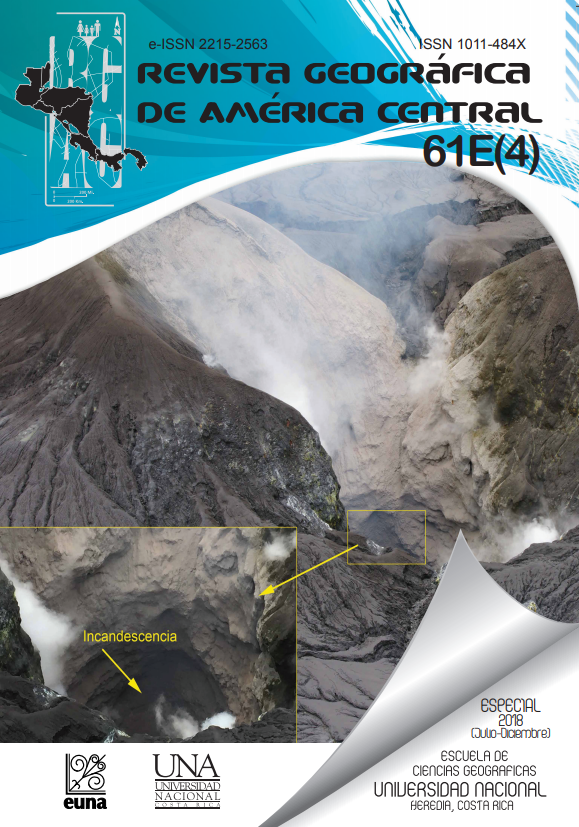Arsenic levels present in water supply systems of Chorotega and Huetar Northern Regions of Costa Rica, Central America
DOI:
https://doi.org/10.15359/rgac.61-4.5Keywords:
Arsenic, drinking water, Costa Rica, Chorotega Region, Huetar Norte RegionAbstract
Arsenic (As) concentrations in water samples for human consumption and use were determined in 106 communal supply system operators in the Chorotega and Huetar Norte regions of Costa Rica during 2013-2017. The samples that recorded As concentrations above the national standard were evaluated for the remaining parameters included in level N3 of the Regulation for drinking water of Costa Rica. The determination of arsenic was made using atomic absorption spectrometry with graphite furnace. The main non-compliances were registered in the districts of Bagaces and Cañas, while in the Huetar Norte region they are presented in Agua Zarcas and Los Chiles. In these districts there is a level of non-compliance with the national standard (10 μg / l) that varies from 66.7% in the case of Los Chiles to 50% in Cañas. The systems that present breaches by As did not register significant temporal variations in the 2013-2017 period. When analyzing the parameters of significant correlations recorded between the As and the other species analyzed, valuable information is obtained related to the hydrogeochemical processes that determine the presence of this metalloid.
References
Abejón, R. & Garea, A. (2015). A bibliometric analysis of research on arsenic in drinking water during the 1992-2012 period: An outlook to treatment alternatives for arsenic removal. Journal of Water Process Engineering. 6, 105-119.
Baig, J.A., Kazi, T.G., Shah, A.Q., Afridi, H., Khan, S., Kolachi, N., Kandhro, G. & Wadhwa, S. (2011). Evaluation of toxic risk assessment of arsenic in male subjects through drinking water in southern Sindh Pakistan. Biological Trace of Elements Research, 143, 772-786.
Bardach, A.E., Ciapponi, A., Soto, N.; Chaparro, M.R., Calderón, M. & Briatore, A. (2015). Epidemiology of chronic disease related to arsenic in Argentina: a systematic review. Science of the Total Environment, 538, 802-816.
Castro, M. (2006) Presencia de arsénico en el agua de bebida en América Latina y su efecto en la salud pública. Centro Panamericano de Ingeniería Sanitaria y Ciencias del Ambiente (CEPIS-SB/SDE/OPS). Congreso International Ciudad de México, 20-24 junio 2006.
Choudhury, R., Mahanta, C., Verma, S. & Mukherjee. A. (2017). Arsenic distribution along different hydrogeomorphic zones in parts of the Brahmaputra River Valley, Assam (India). Journal of Hydrogeology 25,1153-–1163.
Chung, J.Y., Seung, Y. & Young, H. (2014). Environmental source of arsenic exposure. Journal of Prevention Medical and Public Health, 47, 253-257
Huang, L., Wu, H. & van der Kuijp, T.J. (2015). The health effects of exposure to arsenic-contaminated drinking water: a review by global geographical distribution. International Journal of Environmental Health Research, 25, 432-452
International Agency for Research on Cancer (IARC). (2009) Arsenic and Arsenic Compounds. IARC Monographs on the Evaluation of Carcinogenic Risks to Humans Vol. 100C-6. International Agency of Research on Cancer, Lyon, France.
Kumar, S.K., Logeshkumaran, A., Magesh, N.S., Godson, P.S. & Chandrasekar, N. (2015) Hydrogeochemistry and application of water quality index (WQI) for groundwater quality assessment, Anna Nagar, part of Chennai City, Tamil Nadu, India. Applied Water Sciences 5:335–343
Liang, Y. (2007) Transformation and Bioavailability of Arsenic in Soil. Huazhong Agricultural University.
Michael, H.A. (2013). An arsenic forecast for China. Science, 341, 852-853
Monrad, M., Ersbøll, A.K., Sørensen, M., Baastrup, R., Hansen, B., Gammelmark, A. (2017) Low-level arsenic in drinking water and risk of incident myocardial infarction: a cohort study. Environmental Research, 154, 318-324.
Smedley, P.L. (2008). Sources and distribution of arsenic in groundwater and aquifers. C.A.J. Appelo (Ed.), Arsenic in Groundwater: A World Problem, Proceedings of the IAH. Seminar, Utrecht, Netherlands (2008), 4-32
Wang, W., Cheng, S. & Zhang, S. (2014). Association of inorganic arsenic exposure with liver cancer mortality: a meta-analysis. Environmental Research, 135, 120-125.
United States Environmental Protection Agency (US EPA) (1998). Integrated Risk Information System: Arsenic, Inorganic. CASRN; 7440-38-2.
Zhang, Q., Kang, S., Wang, F., Li, C. & Xu, Y. (2008) Major ion geochemistry of Nam Co Lake and its sources, Tibetan Plateau. Aquatic Geochemistry 14(4):321–336
Downloads
Published
How to Cite
Issue
Section
License
Proposed policy for journals offering Open Access
Authors publishing their works in the Journal acknowledge and agree to the following terms:
a) Authors retain the copyrights to their works and guarantee the Journal the right to be the first to publish their works, under the Creative Commons License Attribution-NonCommercial-ShareAlike 4.0 International, CC BY-NC-SA 4.0 International (https://creativecommons.org/licenses/by-nc-sa/4.0/deed.es), which allows others to share works upon complying with the acknowledgment of authorship and mention of the Journal as the original publisher of the work.
b) Authors are permitted to separately establish additional agreements for the non-exclusive distribution of the official edition of the work published in the Journal (for example, authors may desire to place the work in an institutional repository or incorporate it into a book that is to published elsewhere) so long they acknowledgment to recognize the Journal as the original publisher. The aforementioned additional agreements must respect the terms of the non-profit character and sharing philosophy of the original license (CC BY-NC-SA 4.0 International, https://creativecommons.org/licenses/by-nc-sa/4.0/deed.es).
c) Authors are encouraged to archive the post-print or editor/PDF version in Open Access repositories.






 REVGEO is licensed under https://creativecommons.org/licenses/by-nc-sa/4.0/deed.es
REVGEO is licensed under https://creativecommons.org/licenses/by-nc-sa/4.0/deed.es
.svg_4.png)

_(1).png)
_(1)_(1)_(1)_1.png)
(2)(1)(1)(1).png)
